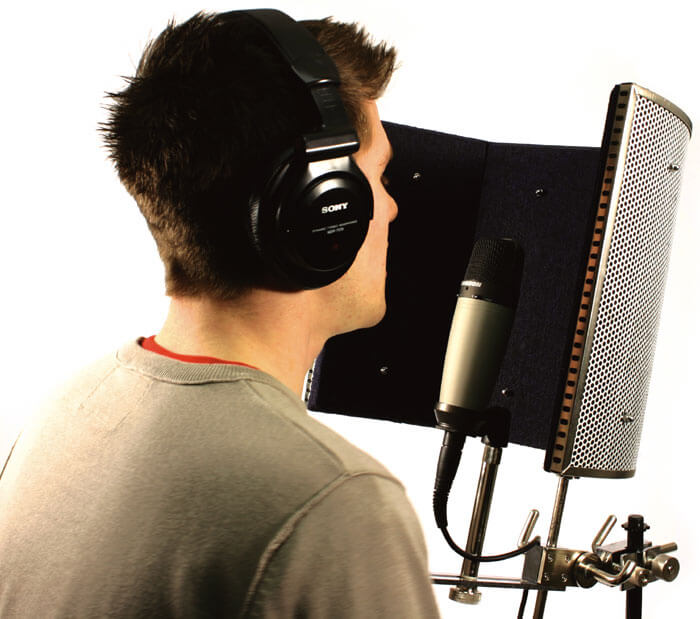One of the questions I get asked a lot is how can I record better?
In the vast majority of cases, the biggest problem is getting the vocals to sound right.
Here are 5 things you can do to record better quality vocals so that when you send them off for mixing, you’re engineer isn’t pulling his hair out and cursing your existence.
1. Cut Out Room Reverb
Most “bad vocals” I receive suffer from too much room reverb.
This is because the rooms they’re being recorded in has too many hard flat surfaces which are causing the vocals to bounce of them and back into the microphone.
How can you fix a room with too much reverberation? Through absorption.
Instead of allowing your voice to bounce around in your room and into your mic, the best way to stop them is to have them absorbed into the surrounding walls and floors.
This is why a must for home studios is acoustic panels.
There is a little bit of a science to how many you need and how far to space them but usually if you have a small size room say 10 feet by 10 feet, you’ll want them spread out about 2 to 4 inches apart from each other.
Keep in mind you don’t want them to cover the whole room, otherwise that will completely kill the acoustics in your room making it sound “dead”.
You’ll have to experiment with coverage as every room has it’s own unique shape and build. Obviously this isn’t an option for everyone as panels can cost over $100 each.
A few years ago, I actually built a few panels for about $60 each and they worked great. Just google “How to Make Acoustic Panels”.
An alternative to acoustic panels are mic shields or reflection filters.
They are little half sphere panels lined with acoustic treatment that connect to your mic stand and create a little vocal booth for you.
These help out, however, you’re still going to have sound hitting your ceiling, floor and wherever else the reflection filter doesn’t cover.
If you’re recording on hardwood or cement, you’re definitely going to want to put down some kind of padding or thick rug to absorb sound.
Again, acoustic floor pads can cost over $100 so it isn’t bad to look for cheaper alternatives: just the other day, I noticed my son has this play mat made of a soft rubber that only costs $4 and covers about 6 square feet, I haven’t tried it yet, but it looks like it could do the trick or at least be an interesting addition to the studio.
For even better sound absorption, get both acoustic panels, mic shield and floor padding.
2. Microphone Check
No you don’t need a $1000 mic.
But you do need something that costs over $100 to get something a talented engineer could work with.
I last wrote about What are the Best Budget Microphones, which is a good starting point for those recording rap vocals.
And please guys, don’t use computer mics! Every time I receive vocals recorded on a computer mic apart of me slowly dies inside and begin to lose all faith in humanity.
3. Don’t Rely on Melodyne or Autotune
Another problem I run into a lot is the use of pitch correction.
Now everyone uses pitch correction that is pretty much an established fact in the year 2013.
However, you don’t have to set it so that you sound like a robot.
And in most cases, if you sing with the autotune off and than later add it, it is going to sound horrible.
So if you must use autotune, record with it on and at very light settings.
If you’re having trouble getting a take right, take your time to nail it until you get it right.
Remember music lasts forever, you don’t want to rush it and think later on, “oh I wish I had taken another 5 minutes to get that to sound how I wanted to”.
4. Hold the Special Effects
Unless you want to have a weird effect on your voice, it is best that you record your vocals as dry as possible and with no fx added.
Don’t add any chorus fx or the main verse vocals or anything that’s not a artistic choice.
If you’re adding fx to make the quality sound better, leave that up to your mix engineer.
They have better equipment and a better trained ear to solve those kind of problems.
Also keep in mind a good mixing and mastering service can improve your song’s sound exponentially.
5. Quality Monitor Headphones
I do get that not everyone can afford $1,000 speakers to actually hear what is going with their music, but why not spring for $100 monitor headphones.
What are monitor headphones?
Well they’re not consumer headphones or $300 Beats By Dre crap that is only going to color the sound.
The great thing about monitor headphones is that they’ll give you an accurate audio picture of what you and your music sound like.
I guarantee a pair of good monitor headphones will drastically improve the artistic choices you make and are well worth the small investment.
FAQ: Recording Better Vocals
1. How can I improve the quality of my vocal recordings?
One common issue in vocal recordings is excessive room reverb, caused by hard, flat surfaces reflecting sound back into the microphone. To reduce room reverb, consider using acoustic panels or mic shields to absorb sound reflections. Alternatively, placing soft padding or rugs on floors can help absorb sound reflections in rooms with hardwood or cement flooring.
2. Do I need expensive equipment to record vocals?
While you don’t need a $1000 microphone, investing in a microphone that costs over $100 is recommended to ensure a decent quality recording that a talented engineer can work with. Avoid using computer mics, as they typically do not provide adequate sound quality for professional recordings.
3. Should I use pitch correction software like Melodyne or Autotune?
Pitch correction software can be useful, but it’s important not to overdo it. Record vocals with pitch correction set to light settings or off, and only use it as needed to enhance the vocals without making them sound robotic. Focus on getting a good take without relying too heavily on pitch correction.
4. Should I add effects to my vocals during recording?
It’s generally best to record vocals as dry as possible, without adding effects like chorus. Save effects processing for the mixing stage, where a mix engineer can use better equipment and expertise to enhance the vocals appropriately.
5. Are monitor headphones necessary for recording vocals?
While $1000 speakers may not be affordable for everyone, investing in $100 monitor headphones can significantly improve your ability to hear and make artistic choices about your music. Monitor headphones provide an accurate audio representation of your recordings, helping you make better mixing and production decisions.









I am from iran and have a Little recording Homestudio. I will to make it acoustic, please send me a Design Plan therefor. The Room is 1.5×2.5×2.5h.
thankful
BRILLIANT!!!
Love it
Thank you Marika!
Hi Andre,
Just discovered your site via Google while trying to understand headroom. Great content, I’ll be visiting often!
That’s interesting that you recommend recording in with Autotune – I was under the assumption that it didn’t matter.
Could recommend settings for light autotune while recording live? My best guess would be about 30 relaxed/choosy and 30 ms tune speed.
Hi Andre, do you mix other genres? Pop, rock, alt. rock? Great advice – thank you…
Birks
Thank you! Yes we mix all genres.
What is the cost to mix and master a track?
You can see our mixing and mastering packages here: http://www.adgmastering.com/mixing/
Well said brother. But you’ve still haven’t told us why we can’t use Beats By Dre to do mixing apart from it being added color to sound .. and what headphone is best for mixing .. thanks ..
Great service